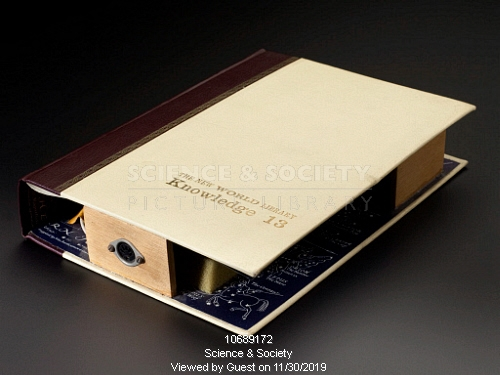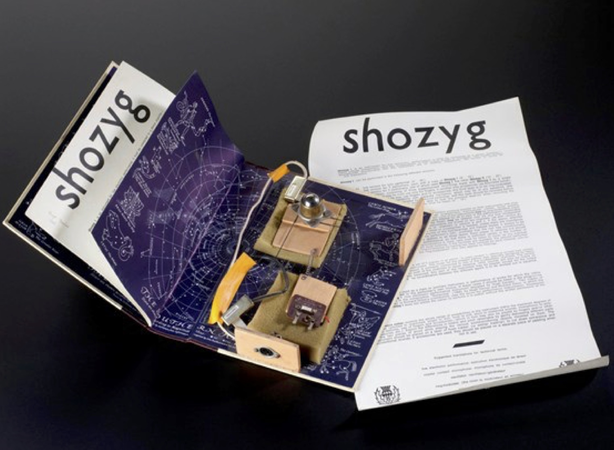The British composer and live electronics pioneer, Hugh Davies (1943- 2005), invented more than 130 concert instruments, sound sculptures, and site-specific installations – many of which made use of different kinds of contact microphones. His work was strongly influenced by his experience as Stockhausen's assistant, between 1964 and 1966. This collaboration started because of a book Davies was writing about the German composer – that at the end has never been published. Quite significant was Davies' close involvement in Mikrophonie I, having participated in its first performances under Stockhausen’s direction. These were the same performances where Fritsch and Gehlhaar were playing, so it's highly possible that Davies was aware of their experiments with contact mics as well.
After the period spent in Cologne, Davies maintained a working relationship with Stockhausen lasting several years. He continued to correct his scores and he performed many of his works in the UK. Before going back home, Davies lived also in Paris and New York, working on compiling the Répertoire international des musiques électroacoustique or International Electronic Music Catalog (RIME), published in 1968. When he returned in the UK he founded the electronic music studio at Goldsmiths College, which he directed until 1986. Four years before, Davies had set up a small studio at the Oxford University, helped by Daphne Oram, a former mentor of Davies, especially while he was still a student. When Davies came back to the UK in 1967 he began building his own instruments, recycling everyday objects, putting contact microphones on them (fig.5), and bringing to the foreground sounds that are not usually part of the realm of musical sounds. The role of amplification, as well as the use of everyday objects in Mikrophonie I, had a profound effect on Davies, marking the point from which he left the electronic music compositions based on tape, to develop his own personal research in live electronic music. In doing so, the influence of Stockhausen was balanced by that of Cage and Tudor,1 especially in regards to the low-fidelity aesthetics and DIY ethos employed in realizing his instruments, as well as the freedom to combine more diverse sound sources. Relying on Raes' statements, Davies worked mostly with magnetic transducers, that he extracted from old headphones or old telephones, and used them as pickups. It seems that Davies was used to collect hundreds of these old things from flea market, as confirmed by Fiorenzo Palermo:
The first magnetic pick-up he used was around 1969 and came from ex-RAF microphones, which he claimed had been used in Spitfires during the Second World War. Subsequently, when the supply of these diminished (he got them from stores in Denmark Street in London), he turned to old telephone handset earpieces or headphones used by the military or by telephone operators. I don’t think Hugh built his own microphones, but rather salvaged and repurposed them. Nonetheless, I have found in my research that in the occasion of a performance of “Sternklang” by Stockhausen in Bonn in 1980 Hugh played an A clarinet with a self-made contact mike and pre-amplifier” (email from Fiorenzo Palermo - 25 May 2019).
In 1968 Davies produced one of his first successful self-contained instruments, the Shozyg I (fig.6), which consists of the last tome of the encyclopedia – volume 13, which includes entries from “Shoal” to “Zygote”, thus from “Sho” to “Zyg” – whose pages had been hollowed out to make space for objects mounted on its inside back cover. The objects inside – a ball-bearing, three fretsaw blades of different length, and two different springs – were grouped in two areas, and each group is amplified by a piezoelectric pickup, chosen according to its filtering characteristics. The objects were played using fingers, fingernails, screwdrivers, needle files, toothbrushes, small electric motors, etc. According to Palermo, Davies had begun using piezoelectric microphones “at least since the establishment of the Goldsmiths Electronic Music studio in 1967, which had two piezos in its initial equipment, and he used these to amplify all kinds of object (combs, broken light bulbs, springs), then recording Galactic Interfaces as a result” (email from Fiorenzo Palermo - 25 May 2019).
In other works, Davies used magnetic pickups instead, as in Concert Aeolian Harp, built from eggslicers: fine fretsaw blades were mounted in parallel on an aluminium frame, which would have then been fixed to a stand. The contact microphones were placed on the edges of the aluminium frame, perpendicular to the blades. The performer should then blow on the fretsaw blades, recalling the sound of an Aeolian harp (see Palermo 2015, pp.191-192). Exploiting the means of amplification Davies brought to the fore sounds that were previously part of background noise, complying with the Cageian aesthetic of ‘small sounds’. The Shozyg I is a good example of Davies' way of building small, compact, and portable instruments, fulfilling the need for immediacy and accessibility. In fact, Davies called the Shozyg I a “musique concrète synthesizer” (Palermo, 2015, p.166-167), considering both its great sound potentialities and the possibility to perform live-electronic music with it.
Between 1968 and 1975 Davies was also a member of Gentle Fire. The other members were Richard Bernas, Patrick Harrex, Graham Hearn, Stuart Jones, Richard Orton, Michael Robinson. Curiously the name Gentle Fire was originated by consulting the I Ching. The group was inquiring the book about the path they need to take: “hexagram No. 37, the Family, came up – the two trigrams of which are Sun and Li, meaning Gentle Wind and Clinging Fire respectively – indicating clearly to the group that they should continue these activities and supplying the name Gentle Fire”( (Davies 2001, p.54). Besides performing a wide range of compositions by living composers – such as Stockhausen, Ashley, Cage, Cardew, Feldman, Wolff, etc. –, Gentle Fire performed collective pieces, composed by the group between 1970 and 1973, further exploring live processing of sound as well as invented instrumentation. In Group Composition III and IV,2 the ensemble shared a single instrument, the gHong (invented by Robinson), made up of three suspended metal oven grills, with a wooden crossbar on the fourth side from which four large springs were suspended. Each side of the gHong was connected to two contact microphones: a high-quality type, such as a stethoscope or transducer, and a contact microphone with a reduced frequency response. By varying the levels on a mixer for each pair of microphones it was possible to obtain substantial filtering effects, so that the use of microphones was crucial in the playing of the gHong. Apparently the gHong was originally meant to satisfy the score instructions of Christian Wolff (see Palermo, 2015, pp.138-140), where the score instructions read: ‘Construct an instrument, or find something, or use an instrument as part of a construction which can make 5 different pitches, or 11 or 3 different pitches; 6 different qualities of sound (they can be made to depend on the manner of performance), or 2; and which can sustain sounds at least somewhat before they begin to fade’, and the different microphones placed on the instruments allowed for an extension of the sounds produced.
Fig.1 Shozyg I (1968), self-built electro-acoustic musical instrument by Hugh Davies.
© Science Museum/Science & Society Picture Library. Shozyg I - AUDIO EXAMPLE
>> go to 1.9 The Artaudofoon - Peter Schat

